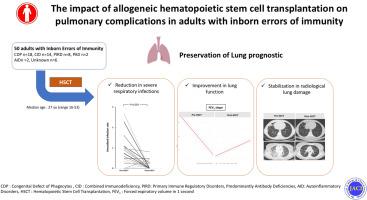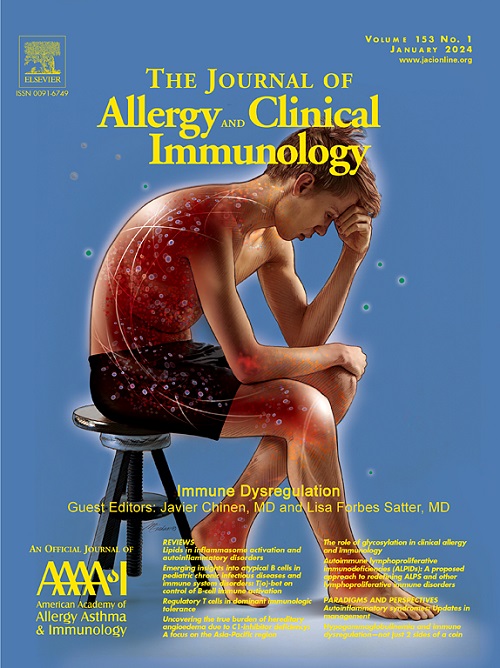异基因造血干细胞移植对先天性免疫缺陷成人肺部并发症的影响。
IF 11.2
1区 医学
Q1 ALLERGY
引用次数: 0
摘要
背景:肺部受累(反复肺部感染、肺实质炎症、瘢痕形成和恶性肿瘤)在先天性免疫错误(IEI)患者中很常见,并在疾病负担中占很大比例。同种异体造血干细胞移植(allogene hematopoietic stem cell transplantation, alloo - hsct)可以治愈大多数严重的IEI。同种异体造血干细胞移植的适应症最近已扩展到成人。目的:我们试图评估同种异体造血干细胞移植对呼吸状态的影响。方法:我们回顾性分析了50名16岁后在法国三个专家中心接受首次同种异体造血干细胞移植的IEI患者的数据。结果随访时间中位数[四分位数间距]为4.8年[IQR: 1.6;9.2],术后随访时间为3年[1.4;6.0]。10例患者死于同种异体造血干细胞移植相关并发症。4例患者出现闭塞性细支气管炎综合征。移植后一年后,严重呼吸道感染的平均年化率(0.14 (95%CI: 0.04;0.24))低于移植前的记录值(0.54 (95%CI: 0.25;0.82);对于等效持续时间的成对比较,P =0.003)。同种异体造血干细胞移植前肺功能下降(平均(95%CI) FEV1:预测- 2.09% /年(-7.27;3.09),但术后肺功能增加(预测+ 2.44% /年(-4.79;9.69),配对比较p=0.0034)。在胸部的CT扫描中,支气管疾病和肺实质空洞是最常见的异常发现。同种异体造血干细胞移植后支气管增厚和细支气管微结节消退,而支气管扩张和残余实质腔稳定。结论同种异体造血干细胞移植可能保护成人IEI患者的长期肺预后;它与严重呼吸道感染的发生率显著降低、肺功能改善和肺损伤的放射学稳定有关。本文章由计算机程序翻译,如有差异,请以英文原文为准。

The impact of allogeneic hematopoietic stem cell transplantation on pulmonary complications in adults with inborn errors of immunity
Background
Pulmonary involvement (repeated lung infections, lung parenchymal inflammation, scarring, and malignancies) is frequent in patients with inborn errors of immunity (IEIs) and accounts for a significant proportion of the disease burden. Allogeneic hematopoietic stem cell transplantation (allo-HSCT) can cure most severe IEIs. The indications for allo-HSCT have recently been extended to adults.
Objective
We sought to assess the impact of allo-HSCT specifically on respiratory status.
Methods
We retrospectively analyzed data of 50 patients with IEIs who underwent a first allo-HSCT after the age of 16 at 3 expert centers in France.
Results
The median length of follow-up was 4.8 years (interquartile range: 1.6-9.2) before allo-HSCT and 3 years (interquartile range: 1.4-6.0) after allo-HSCT. Ten patients died as a result of allo-HSCT–related complications. Four patients developed bronchiolitis obliterans syndrome. After 1-year posttransplantation, the mean annualized rate of severe respiratory infections (0.14 [95% CI: 0.04 to 0.24]) was lower than the value recorded before transplantation (0.54 [95% CI: 0.25 to 0.82]; P = .003 for paired comparisons of equivalent durations). Lung function was declining before allo-HSCT (mean FEV1: −2.09% predicted/year [95% CI: −7.27 to 3.09]) but increased afterward (+2.44% predicted/year [95% CI: −4.79 to 9.69], P = .0034 for paired comparisons). On computed tomography scans of the chest, bronchial disorders and lung parenchyma cavities were the most frequent abnormal findings. The bronchial thickening and bronchiolar micronodules regressed after allo-HSCT, whereas bronchiectasis and residual parenchymal cavities were stable.
Conclusions
allo-HSCT seems likely to protect the long-term pulmonary prognosis of adults with IEIs; it is associated with a significantly lower incidence of severe respiratory infections, better lung function, and radiologic stabilization of lung damage.
求助全文
通过发布文献求助,成功后即可免费获取论文全文。
去求助
来源期刊
CiteScore
25.90
自引率
7.70%
发文量
1302
审稿时长
38 days
期刊介绍:
The Journal of Allergy and Clinical Immunology is a prestigious publication that features groundbreaking research in the fields of Allergy, Asthma, and Immunology. This influential journal publishes high-impact research papers that explore various topics, including asthma, food allergy, allergic rhinitis, atopic dermatitis, primary immune deficiencies, occupational and environmental allergy, and other allergic and immunologic diseases. The articles not only report on clinical trials and mechanistic studies but also provide insights into novel therapies, underlying mechanisms, and important discoveries that contribute to our understanding of these diseases. By sharing this valuable information, the journal aims to enhance the diagnosis and management of patients in the future.

 求助内容:
求助内容: 应助结果提醒方式:
应助结果提醒方式:


